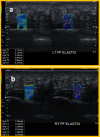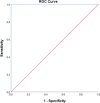Ultrasound imaging and shear wave elastography for the differential diagnosis of heel pain: a comparative cross-sectional study
- PMID: 38879835
- PMCID: PMC11333687
- DOI: 10.1007/s40477-024-00906-8
Ultrasound imaging and shear wave elastography for the differential diagnosis of heel pain: a comparative cross-sectional study
Abstract
Purpose: In correlation with magnetic resonance imaging (MRI), this study attempts to assess the effectiveness of the diagnostic of ultrasonography (US) features and shear wave elastography (SWE) in determining the different causes of heel pain.
Materials and methods: 55 heels with a mean age of 38.33 ± 10.8 were included in the study (10 control cases and 41 cases, 4 of which had bilateral heel pain). There were 23 female cases (56.1%) and 18 male cases (43.95%). Examinations using shear wave elastography (SWE) and ultrasound (US) were done in different positions. MRI and the obtained data were correlated.
Results: When used to diagnose different heel pain causes, ultrasound demonstrated great sensitivity and specificity. SWE demonstrated a good correlation with MRI findings and enhanced the ultrasound's diagnostic precision in identifying plantar fasciitis early on (increased accuracy from 88.9 to 93.33% with 100% sensitivity and 83.3% specificity) and Achilles tendinopathy (increased accuracy from 88.9 to 97.8 with 94.7% sensitivity and 100% specificity).
Conclusion: In summary, we concluded that heel pain can be efficiently examined by both ultrasound (US) and shear wave elastography (SWE) with the former being used as the primary effective tool and the latter being done to increase diagnostic accuracy. We also concluded that SWE improved the ultrasound's diagnostic precision in identifying patients with early plantar fasciitis and Achilles tendinopathy and showed a robust relationship with clinical outcomes, enhancing patient evaluation and follow-up.
Keywords: Achilles tendon; Heel pain; MRI; Plantar fasciitis; Shear wave elastography; Ultrasonography.
© 2024. Società Italiana di Ultrasonologia in Medicina e Biologia (SIUMB).
Conflict of interest statement
The authors have no relevant financial or non-financial interests to disclose.
Figures











References
-
- Weerakkody Y, Sharma R, Ibrahem H et al (2024) Achilles tendinopathy. Radiopaedia.org. 10.53347/rID-40410
-
- Pirri C, Stecco C, Güvener O et al (2024) EURO-MUSCULUS: European Musculoskeletal Ultrasound Study Group in Physical and Rehabilitation Medicine. EURO-MUSCULUS/USPRM Dynamic Ultrasound Protocols for Ankle/Foot. Am J Phys Med Rehabil 103(3):e29–e34. 10.1097/PHM.0000000000002349 10.1097/PHM.0000000000002349 - DOI - PubMed
Publication types
MeSH terms
LinkOut - more resources
Full Text Sources

